|
|
|
|
|
|
|
|
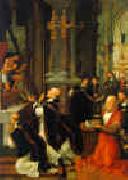 |
Adriaen Isenbrandt
|
|
Flemish Northern Renaissance Painter, ca.1500-1551
There are only a few documentary records of his life, and some mentions in literature from his lifetime or soon after, but he cannot be documented as the creator of any surviving work; everything else consists of hypothesis. It is possible that he was born in Haarlem or even in Antwerp about 1490. It is not known where or with which painter he served his apprenticeship.
He is named for the first time in 1510, when he came to Bruges and bought his burghership. In November of the same year he already became master in the painters?? Guild of St. Luke and the goldsmiths?? guild of St. Elooi. He was later elected nine time a deacon and twice the governor of the guild.
Soon he had an important workshop, probably in the Korte Vlaminckstraat in Bruges. This was close to the workshop of Gerard David, at the Vlamijncbrugghe and the former workshop of Hans Memling. Bruges, at that time, was one of the richest towns in Europe. Rich traders and merchants ordered diptychs and portraits for personal use. Isenbrandt painted mainly for private clients. However, there were some paintings that were created without any particular commission. He had enough work to even put out work to other painters in Bruges, as a legal suit from 1534 by Isenbrandt against Jan van Eyck (not the famous one) for non-delivery of paintings he had ordered, demonstrates. He was also appointed the agent in Bruges of the painter Adriaan Provoost (son of Jan Provoost), who had moved to Antwerp in 1530. Contemporary sources therefore mention Isenbrandt as a famous and well-to-do painter.
He married twice, the first time with Maria Grandeel, daughter of the painter Peter Grandeel. They had one child. After her death in 1537, he married again in 1547 with Clementine de Haerne. This second marriage resulted in two daughters and a son. He also had an extramarital daughter with the innkeeper Katelijne van Brandenburch (who was at the same the mistress of his friend Ambrosius Benson).
When he died in 1551, he was buried alongside his first wife at the cemetery of the St. Jacob church in Bruges; his children inherited no less than four houses with surrounding property. |
|
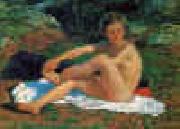 |
Alexander Ivanov
|
|
1806-1858
Russian Alexander Ivanov Galleries
was a Russian painter who adhered to the waning tradition of Neoclassicism but found little sympathy with his contemporaries.
Ivanov studied together with Karl Briullov at the Imperial Academy of Arts under his father, Andrey A. Ivanov. He spent most of his life in Rome where he befriended Gogol and succumbed to the influence of the Nazarenes. He has been called the master of one work, for it took 20 years to complete his magnum opus, The Appearance of Christ before the People (1837-57).
It was for the next generation of art critics to do him justice. Some of the numerous sketches he had prepared for The Appearance have been recognized as masterpieces in their own right. Although Ivanov's major painting is a gem of the Tretyakov Gallery, the most comprehensive collection of his works can be viewed at the Russian Museum in St Petersburg. |
|
|
|
 |
Arkhip Ivanovich Kuindzhi
|
|
Russian Painter, 1842-1910
Ukrainian painter, active in Russia. Initially self-taught as an artist, he twice failed the St Petersburg Academy's entrance examination, despite coaching by the marine painter Ivan Aivazovsky. In 1868, however, he was accepted as an external student. He persevered against conservative prejudice and poverty throughout his early career, supplementing his income by retouching photographs. In his early landscape paintings he often sought to capture seasonal moods, as in Autumn Mud (1872; St Petersburg, Rus. Mus.). A more human focus, however, is noticeable after 1874, when he joined the travelling exhibitions society the WANDERERS: the village houses dominate the landscape setting in Evening in Ukraine (1878; St Petersburg, Rus. Mus.). Kuindzhi's principal interest, however, was in lighting, and he obtained striking effects by using vivid colours, chiaroscuro contrasts and simple but cleverly conceived designs. Spectacular paintings, such as the Birch Grove (1879; Moscow, Tret'yakov Gal.), greatly moved contemporary viewers. Through years of experimentation, Kuindzhi developed a highly original technique, which he applied to an increasingly typical, at times almost visionary, treatment of subjects such as snow-covered mountains and moonlight (e.g. Elbnis: Moonlit Night, 1890-95; Moscow, Tret'yakov Gal.). Due to imperfections in the paints he used, many of his canvases soon darkened. |
|
|
|
 |
Bernardino india
|
|
Italian Emilian painter , 1528-1590
was a painter of the late Renaissance, born and mainly active in Verona. He is said to have trained with Domenico Riccio. He collaborated with Michele Sanmicheli in the Canossa palace and Pellegrini chapel in San Bernardino of Verona. He collaborated with Felipe Brusasorci, Domenico's son in frescoes at Palazzo Fiorio Della Seta. He decorated Palladian villas such as Villa Pojana, Villa Foscari (also known as La Malcontenta) where Giovanni Battista Zelotti also worked, and the Palazzo Thiene in Vicenza. Orlando Flacco completed his most extensive work for the Sala Maggior di Consiglio in Verona. |
|
|
|
|
|
|
|
|
|
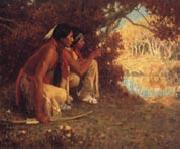 |
Eanger Irving Couse
|
|
American Painter , b.1866 d.1936
was an artist and founding member of the Taos artists colony in Taos, New Mexico. Couse was born in Saginaw, Michigan, where he first started drawing the Chippewa Indians who lived nearby. Couse attended the Art Institute of Chicago, and the National Academy of Design, New York. He left for Paris to study at the Ecole des Beaux-Arts and Academie Julian under Bouguereau. He lived in France 10 years, where he painted charming scenes of the Normandy coast. After his return to America he devoted himself to depicting the life and habits of the Taos Indians, a pueblo tribe in New Mexico. He reveals the poetical and philosophical rather than the savage and warlike side of the Indians, and his skillfully executed pictures are full of sentiment. |
|
|
|
|
|
|
|
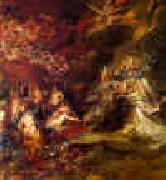 |
Eugene Isabey
|
|
1803-1886
French
Eugene Isabey Galleries
Born in Paris, the son of Jean-Baptiste Isabey, a painter as well, Eug??ne Isabey studied and worked at the Louvre Museum. Early in his career his paintings consisted of mostly watercolor landscapes. In 1820, he travelled to Normandy and Britain painting land and seascapes.
Isabey journeyed with the French Expedition to Algiers in 1830 as an illustrator. Yet, the trip's paintings sold poorly on the market and encouraged him to switch to narrative and historical painting. He was later selected to become one of Louis-Philippe??s court painters. |
|
|
|
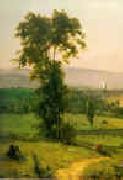 |
George Inness
|
|
1825-1894
George Inness Galleries
George Inness (May 1, 1825 -August 3, 1894), was an American landscape painter; born in Newburgh, New York; died at Bridge of Allan in Scotland. His work was influenced, in turn, by that of the old masters, the Hudson River school, the Barbizon school, and, finally, by the theology of Emanuel Swedenborg, whose spiritualism found vivid expression in the work of Inness' maturity. He is best known for these mature works that helped define the Tonalist movement.
Inness was the fifth of thirteen children born to John Williams Inness, a farmer, and his wife, Clarissa Baldwin. His family moved to Newark, New Jersey when he was about five years of age. In 1839 he studied for several months with an itinerant painter, John Jesse Barker. In his teens, Inness worked as a map engraver in New York City. During this time he attracted the attention of French landscape painter Regis François Gignoux, with whom he subsequently studied. Throughout the mid-1840s he also attended classes at the National Academy of Design, and studied the work of Hudson River School artists Thomas Cole and Asher Durand; "If", Inness later recalled thinking, "these two can be combined, I will try."
Concurrent with these studies Inness opened his first studio in New York. In 1849 Inness married Delia Miller, who died a few months later. The next year he married Elizabeth Abigail Hart, with whom he would have six children. |
|
|
|
|
|
|
|
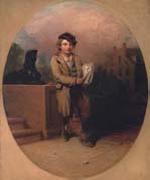 |
Henry Inman
|
|
American Painter, 1801-1846,was an American portrait, genre, and landscape painter.He was born at Utica, N. Y., October 20, 1801, and was for seven years an apprentice pupil of John Wesley Jarvis in New York City. He was the first vice president of the National Academy of Design. He excelled in portrait painting, but was less careful in genre pictures. Among his landscapes are "Rydal Falls, England," "October Afternoon," and "Ruins of Brambletye." His genre subjects include "Rip Van Winkle," "The News Boy," and "Boyhood of Washington;" his portraits, those of Henry Rutgers and Fitz-Greene Halleck in the New York Historical Society, of Bishop White, Chief Justices Marshall and Nelson, Jacob Barker, William Wirt, Audubon, DeWitt Clinton, Martin Van Buren, and William H. Seward. |
|
|
|
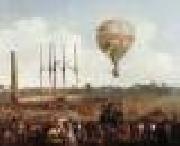 |
IBBETSON, Julius Caesar
|
|
English Painter, 1759-1817
English painter, printmaker and writer. The son of a clothier, he was apprenticed to John Fletcher, a ship painter in Hull; in 1775 Ibbetson became a scene-painter there. In 1777 he moved to London, where he worked as a scene-painter and picture restorer. He married about three years later. From 1785 he exhibited landscapes, genre scenes and portraits at the Royal Academy. In 1787-8 Ibbetson was personal draughtsman to Col. Charles Cathcart on the first British Mission to Beijing, a voyage that included visits to Madeira, the Cape of Good Hope and Java. His watercolour False Bay, Cape of Good Hope (London, V&A), made on this journey, shows a picturesque roughness of foliage and rustic staffage adapted from his English landscape style. Cathcart's death forced Ibbetson to return to England (he exhibited an oil painting, untraced, of the Burial of Col. Cathcart in Java at the Royal Academy in 1789); thereafter he lived by painting landscape oils and watercolours, the subjects culled from his frequent tours. He painted occasional portraits throughout his career (e.g. Young Man, 1790; Leeds, Temple Newsam House) and contributed to John Boydell's Shakespeare Gallery (e.g. Scene from 'The Taming of the Shrew', untraced, see Waterhouse, p. 192). In 1789 he stayed with John Stuart, 3rd Earl of Bute, at Cardiff Castle and visited the Isle of Wight in 1790. In 1792 he toured Wales and the surrounding area with the painter John 'Warwick' Smith and his companion Robert Fulke Greville, resulting in the publication of his book of engravings, A Picturesque Guide (1793). His oil painting of Aberglasyn: The Flash of Lightning (Leeds, C.A.G.) evokes the sublimity of the mountainous Welsh terrain; the drama of the storm over Aberglasyn is conveyed by thick impasto and strong chiaroscuro, a way of handling paint that Ibbetson learnt from copying 17th-century Dutch masters while working for a London dealer named Clarke during the late 1770s and early 1780s. |
|
 |
Ignacio Pinazo
|
|
1849-1916
He came from a poor family and in his youth worked as a silversmith, gilder, tile painter and hatter. This experience encouraged an independent spirit unencumbered by academic doctrine. He did, however, attend the Escuela de Bellas Artes in Valencia while working as a hatter, studying colour and composition, life drawing and drawing from the Antique (1868-9). In 1870 he started to devote himself wholly to painting. His early works include several portraits. A series of stays in Italy were important for Pinazo's development. The first of these took place in 1873, when he spent seven months visiting Rome, Naples and Venice and became familiar with the work of Mariano Jos? Bernardo Fortuny y Marsal, whose influence can be seen in Pinazo's small-scale landscapes on panel . Soon, however, his work came to resemble that of the impressionistic Italian painters, the Macchiaioli, as in Pinazo's brightly coloured Wheat-field. His second stay in Italy began in 1877 with an award for his large history painting, Landing of Francis I of France in Valencia |
|
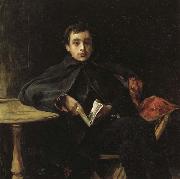 |
Ignacio Pinazo Camarlench
|
|
Spanish painter , 1849-1916
was a Spanish painter, and one of the most prominent artists of Valencia from the end of the nineteenth century, working in the Impressionist style. Born into a poor family, Pinazo was forced from a young age to assist in supporting the family by practising various trades. He had only attended eight grades when his mother died of the cholera, and young Ignazio was variously employed as a silversmith, a painter of tiles, and a decorator of fans. After his father's death, he lived with his grandparents, and in 1864 enrolled in the San Carlos Academy of Fine Arts, Valencia, earning his living as a hatter. His artistic career started when he was 21, and he achieved his first success in Barcelona three years later. In 1871, work by him was displayed in the National Exhibition of Fine Arts for the first time. He visited Rome twice, the first time (1873) thanks to the sale of a painting. From 1876 to 1881 he lived in that city on a grant. When he returned to his native city in 1874, he abandoned the conventional historic themes he had so far devoted his efforts to, and instead started painting family subjects, nude figures, and scenes from daily life, thereby anticipating Joaqu'n Sorolla y Bastida and Francisco Domingo both in subject and style. |
|
 |
Ignacio Zuloaga
|
|
Spanish Painter, 1870-1945
was a Spanish Basque painter, born in Eibar, in the Basque country, near the monastery of Loyola. He was the son of metalworker and damascener Placido Zuloaga and grandson of the organizer and director of the royal armoury in Madrid. In his youth, he drew and worked in his father's workshop. He was educated by the Jesuits in France. His father wanted him to be an architect, and with this objective in mind, he was sent to Rome, where he immediately followed the strong impulse that led him to painting. After only six months' work he completed his first picture, which was exhibited at the Paris Salon of 1890. Continuing his studies in Paris, where he lived for five years, he was strongly influenced by Paul Gauguin and Henri de Toulouse-Lautrec. Only upon returning to his native land did he find his true style, which is based on the national Spanish tradition embodied in the work of Diego Velazquez, Francisco de Zurbaran, El Greco, and Francisco Goya. Bleeding Christ; or Blood Christ (El cristo de la Sangre) (1911)His own country was slow in acknowledging the young artist whose strong, decorative and rugged style stood in opposition to the styles of well-known modern Spanish artists such as Fortuny, Madrazo, |
|
 |
Ignacio Zuloaga y Zabaleta
|
|
July 26, 1870 - October 31, 1945
Spanish Basque painter. He studied in Paris in 1891, coming under the influence of Impressionism and of the group of Catalan painters around Santiago Rusieol. His visit to Andalusia in 1892 provided the key to his later work, leading him to replace the grey tonalities of his Paris paintings with more brightly coloured images of Spanish folkloric subjects and of male or female figures in regional dress, for example Merceditas (1911/13; Washington, DC, N.G.A.). Zuloaga turned to Castilian subjects in works such as Segoviano and Toreros de Pueblo (both 1906; both Madrid, Mus. A. Contemp.) after the defeat suffered by Spain in the Spanish-American War of 1898; like the group of writers known as the Generation of 98, with whom he was associated and who were among his most articulate supporters, he sought to encourage the regeneration of his country culture but with a critical spirit.. |
|
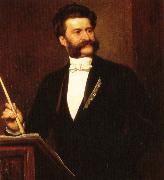 |
ignaz moscheles
|
|
Period: Romantic (1820-1869)
Country: Germany/Czech Rep.
Born: May 23, 1794 in Prague
Died: March 10, 1870 in Leipzig
Genres: Concerto, Keyboard Music |
|
 |
Ignazio Danti
|
|
Italian,1536-1586
was an Italian priest, mathematician, astronomer, and cosmographer. Danti was born in Perugia to a family rich in artists and scientists. As a boy he learned the rudiments of painting and architecture from his father Giulio, an architect and engineer who studied under Antonio da Sangallo, and his aunt Teodora, who was said to have studied under the painter Perugino and also wrote a commentary on Euclid. His older brother Vincenzo Danti would become one of the leading court sculptors of late-sixteenth-century Florence, while his younger brother Girolamo (1547-1580) would become a local Perugian painter of little fame. Danti entered the Dominican Order on March 7, 1555, changing his baptismal name from Pellegrino to Ignazio. After completing his studies in philosophy and theology he gave some time to preaching, but soon devoted himself zealously to mathematics, astronomy, and geography. In 1562, he requested a transfer from the Dominican compound in Perugia to the monastery of San Marco in Florence. Soon after, he found work on the side tutoring the children of wealthy Florentines in mathematics and science. In September 1563, he was invited by Cosimo I, Duke of Tuscany to participate in his great cosmographical project, the Guardaroba in the Palazzo Vecchio. Over the next dozen years, Danti would paint 30 maps of regions of the world (based largely upon published prints by Giacomo Gastaldi, Abraham Ortelius, Gerardus Mercator, and others) upon the cabinet doors of the Guardaroba. He would also work on many other significant scientific and cosmographic projects in Florence, including the large terrestrial globe of the Guardaroba (1564-1568), and a number of brass scientific instruments (such as an astrolabe) today in the Museo di Storia della Scienza in Florence. Between 1567 and 1569, Pius V, who belonged to the Dominicans, is said to have commissioned Danti to furnish plans for the construction of a Dominican church and convent at Bosco Marengo in Piedmont; Danti acted mainly as an advisor. During his stay in Florence, Danti taught mathematics and published over a dozen scientific treatises, mostly commentaries on ancient and medieval astronomy and mathematics or explanations of how to use scientific instruments. For much of his time in Florence, Danti resided at the convent of Santa Maria Novella, and designed the quadrant (on the right) and the armillary sphere (on the left) that appear on the end blind arches of the lower facade of the church in 1572 and 1574, respectively. He also designed a large-scale gnomon for the church which would allow a thin beam of light to enter the church at noon each day through a hole just beneath the facade's rose window, although it probably was not completed by the time Danti left Florence. There were also discussions between the Duke and Danti about building a canal to place Florence in communication with both the Mediterranean and the Adriatic. However, this grandiose plan never got underway before Cosimo's death in (1574). The following year Cosimo's son, Grand Duke Francesco I de' Medici, forced Danti to leave Florence (in late September 1575) on an uncertain morals charge. It is not known precisely why Francesco exiled Danti, but it should be noted that the Dominican had no trouble finding work or patrons anywhere else in Italy, although he never returned to Florence before his death. After leaving Florence, Danti became professor of mathematics at the University of Bologna. While occupying this chair he built a massive gnomon in the Bolognese church of San Petronio, the meridian line of which is still visible in the church's pavement. He also spent some time in Perugia, at the invitation of the governor, where he prepared maps of the Perugian republic. On account of his mathematical attainments, Pope Gregory XIII invited him to Rome, appointed him pontifical mathematician and made him a member of the commission for the reform of the calendar. He also placed him in charge of the painters whom the Pope had summoned to the Vatican to continue the decoration of the palace, most notably to make a number of maps of the regions of modern Italy in the newly constructed Gallery of Maps along the Cortile del Belvedere. This remarkable project, begun in early 1580 and completed about 18 months later, maps the entirety of the Italian peninsula in 40 large-scale frescoes, each depicting a region as well as a perspective view of its most prominent city. When the pontiff commissioned the architect Domenico Fontana to repair the Claudian harbour it was Danti who furnished the necessary plans. While at Rome Danti published a translation of a portion of Euclid with annotations and wrote a life of the architect Jacopo Barozzi da Vignola, preparing also notes for the latter's work on perspective. In recognition of his labours Gregory, in 1583, made him Bishop of Alatri in the Campagna. Danti showed himself a zealous pastor in his new office. |
|
|
|
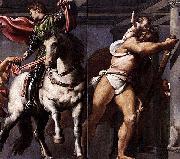 |
Il Pordenone
|
|
(c. 1484 - 1539), was an Italian painter of the Venetian school, active during the Renaissance. Vasari, his main biographer, identifies him as Giovanni Antonio Licinio.
He was commonly named il Pordenone from having been born in 1483 at Corticelli, a small village near Pordenone in Friuli. He ultimately dropped the name of Licinio, having quarrelled with his brothers, one of whom had wounded him in the hand; he then called himself Regillo, or De Regillo. Others say he once took up his maternal name of Cuticelli[1] His signature runs Antonius Portunaensis, or De Portunaonis. He was knighted as a cavaliere by Charles V.
As a painter, Pordenone was a scholar of Pellegrino da San Daniele, but a leading influence of his style was Giorgione; the popular story that he was a fellow-pupil with Titian under Giovanni Bellini is false. It was claimed that Pordenone's first commission was given him by a grocer in his home town, to try his boast that he could paint a picture as the priest commenced High Mass, and complete it by the time Mass was over; he completed the picture in the required time.[2] The district about Pordenone had been somewhat fertile in capable painters; but Pordenone is the best known, a vigorous chiaroscurist and flesh painter. The 1911 Britannica states that "so far as mere flesh-painting is concerned he was barely inferior to Titian in breadth, pulpiness and tone". The two were rivals for a time, and Licinio would sometimes affect to wear arms while he was painting. He excelled in portraits; he was equally at home in fresco and in oil-color. He executed many works in Pordenone and elsewhere in Friuli, Cremona, and Venice; at one time he settled in Piacenza, where one of his most celebrated church pictures, St. Catherine disputing with the Doctors in Alexandria is located; the figure of St. Paul in connection with this picture is his own portrait.
|
|
|
|
|
|
 |
Ilya Ostroukhov
|
|
1858-1929. Was a Russian painter. Ostroukhov was born to a rich family. In 1885, Ostroukhov joined the Association of Travelling Art Exhibitions. Ostroukhov was primarily a landscape painter. |
|
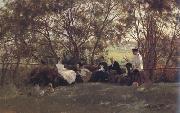 |
Ilya Repin
|
|
Ukrainian-born Russian Realist Painter, 1844-1930
was a leading Russian painter and sculptor of the Peredvizhniki artistic school. An important part of his work is dedicated to his native country, Ukraine. His realistic works often expressed great psychological depth and exposed the tensions within the existing social order. Beginning in the late 1920s, detailed works on him were published in the Soviet Union, where a Repin cult developed about a decade later, and where he was held up as a model "progressive" and "realist" to be imitated by "Socialist Realist" artists in the USSR. Repin was born in the town of Chuhuiv near Kharkiv in the heart of the historical region called Sloboda Ukraine. His parents were Russian military settlers. In 1866, after apprenticeship with a local icon painter named Bunakov and preliminary study of portrait painting, he went to Saint Petersburg and was shortly admitted to the Imperial Academy of Arts as a student. From 1873 to 1876 on the Academy's allowance, Repin sojourned in Italy and lived in Paris, where he was exposed to French Impressionist painting, which had a lasting effect upon his use of light and colour. Nevertheless, his style was to remain closer to that of the old European masters, especially Rembrandt, and he never became an impressionist himself. |
|
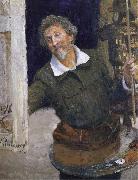 |
Ilya Yefimovich Repin
|
|
1844-1930
After training with a provincial icon painter and at the St. Petersburg Academy of Fine Arts, he visited France and Italy on an academy scholarship. On his return he began painting subjects from Russian history. In 1873 he achieved international fame with Volga Boatmen, a grim, powerful image that became the model for Soviet Socialist Realism. Among his best-known works is Ivan the Terrible and His Son Ivan (1895), depicting Ivan's murder of his son. He also painted vigorous portraits (including Leo Tolstoy and Modest Mussorgsky). In 1894 he became professor of historical painting at the St. Petersburg Academy. |
|
|
|
|
|
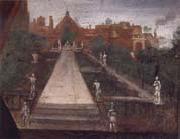 |
Inigo Jones
|
|
English Baroque Era Architect, 1573-1652,Masque designer, architect, and courtier, Jones's architectural legacy only fructified in the early 18th cent. through the neo-Palladian movement. Yet Jones personally remains frustratingly elusive, for all his arrogance and engrossing power as surveyor of the king's works (1615-44). Apart from entrancing scenic and costume designs, only seven of Jones's 45 architectural works survive: the most notable are the Whitehall Banqueting House, Queen's chapel at St James's, Queen's House at Greenwich, and, by no means least because of its Carolean town-planning context, St Paul's church, Covent Garden. |
|
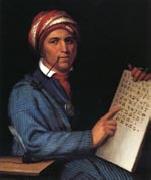 |
Inman Henry
|
|
American portrait, genre, and landscape painter, 1801-1846
The son of an English land agent who had emigrated to America in 1792, he studied under an itinerant drawing-master before moving to New York with his family in 1812. Two years later he obtained an apprenticeship with the city's leading portrait painter, John Wesley Jarvis, drawn to the artist not only for his skill but also for his collection of pictures, which at that time included Adolf Ulric Wertmuller's Danae and the Shower of Gold (1787; Stockholm, Nmus.). Inman worked closely with Jarvis, eventually accompanying him on his travels and serving more as a collaborator than an apprentice. Within this partnership Inman established a speciality in miniature painting. In 1823 he set up his own practice in New York and ceded miniature painting to his student and eventual partner Thomas Seir Cummings (1804-94). |
|
 |
Ion Andreescu
|
|
n. 15 februarie 1850, Bucuresti . 22 octombrie 1882, Bucuresti
He was born in Bucharest into a merchant family. In 1869 he entered Theodor Aman Fine Arts School.
By 1872 he was an instructor of drawing and calligraphy at the Bishop School in Buzau. In 1873 he left the Bishop School for the Tudor Vladimirescu Communal Secondary School, also in Buzau. Then, in 1875 he left the Communal Secondary School for Buzau Craftsmanship School.
Influenced by Nicolae Grigorescu, he left Romania for Paris to further his education. In Paris, he began painting at Barbizon. His work was exhibited with the works of better known painters such as Manet, Monet and Renoir.
In 1881 he returned to Romania, ill with tuberculosis. His death followed shortly in 1882. |
|
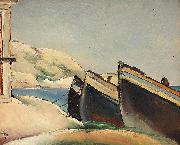 |
Ion Theodorescu Sion
|
|
Ion Theodorescu-Sion (1882-1939).
Alternative names Onu Soare Teodor.
Romanian painter.
|
|
|
|
 |
Isaac Cruikshank
|
|
English Illustrator, ca.1756-1811
Scottish painter and caricaturist, was born in Edinburgh. His sons Isaac Robert Cruikshank (1789-1856) and George Cruikshank also became artists, and the latter in particular achieved fame as an illustrator and caricaturist. Cruikshank is known for his social and political satire. His parents were Elizabeth Davidson (b. c.1725), daughter of a gardener, and Andrew Crookshanks (c.1725 Cc.1783), a former customs inspector dispossessed for his role in the Jacobite uprising of 1745. He studied with a local artist, possible John Kay (1742 C1826), and travelled with his master to London in 1783. He married Mary MacNaughton (1769 C1853) in 1788 and the couple had five known children, two of whom died in infancy. A daughter, Margaret Eliza, also a promising artist, died at the age of eighteen. Cruikshank's first known publications were etchings of Edinburgh "types", from 1784. He produced illustrations for books about the theatre, did the frontispiece for Witticisms and Jests of Dr Johnson (1791), and illustrated George Shaw's extensive General Zoology (1800 C26). His watercolours were exhibited, but in order to make a living it was more lucritive to produce prints and caricatures. He was responsive to the marketplace but firm in his dislikes of Napoleon and political radicals. He and Gillray developed the figure of John Bull, the nationalistic representation of a solid British yeoman. Publisher John Roach was a friend and patron, and he later worked with print dealer S. W. Fores and Johnny Fairburn. He also collaborated, with G. M. Woodward, and later, with his son George. Cruikshank died of alcohol poisoning at the age of fifty-five as a result of a drinking contest and is buried near his home in London. |
|
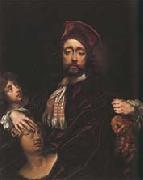 |
Isaac Fuller
|
|
c.1606--72
English painter. He was renowned in his day for large historical, mythological and biblical subjects but was also a very able portrait painter. According to Vertue, he studied under Fran?ois Perrier in France c. 1630, and in 1644 he is documented as working in Oxford, at the same time as William Dobson. There he painted altarpieces, including a Resurrection for All Souls College (a wild imitation of Michelangelo, which John Evelyn considered 'too full of nakeds for a chapel'), a Last Judgement for Magdalen College and a Last Supper for Wadham College. None of these works is known to survive. He also copied Dobson's Beheading of John the Baptist, substituting the heads with portraits of his friends. On moving to London, Fuller worked on decorative schemes for churches, taverns and private houses and continued to paint portraits. In 1654 he published a drawing book, Un libro di disegnare, with 15 etched plates, but there are no known copies. Much of his decorative work was destroyed in the Great Fire in 1666, including that in the Painters' Hall and St Mary Abchurch. Vertue admired his erotic life-size Bacchic figures in the Mitre Tavern in Fenchurch Street. Five crudely painted canvases commemorating the Adventures of Charles II after the Battle of Worcester in 1651 (London, N.P.G.) are his only surviving decorative works. Fuller's reputation as a painter rests mainly on three variants of a Rembrandtesque Self-portrait (1670; Oxford, Bodleian Lib.; Oxford, Queen's Coll |
|
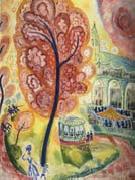 |
Isaac Grunewald
|
|
Swedish, 1889-1946,was a Swedish-Jewish Expressionist painter born in Stockholm. Having studied at a Swedish art school, at age nineteen Gr??newald travelled to Paris to study under Henri Matisse. In 1909 he gained recognition in his homeland when he exhibited his work at Halldins konsthandel. He met Fauvist painter Sigrid Hjert??n, who had studied at the College of Crafts and Design in Stockholm, and encouraged her to return with him to study in Paris. Married in 1911, they became part of a group of Scandinavian artists known as "De Unga" (The Young Ones). The Crane (1915) by Isaac GrunewaldGrenewald and Hjerten regularly exhibited together at home and abroad and art historians now often cite them as being responsible for introducing modernism to Sweden. At a time in history when anti-Semitism was widespread and women in art were frowned upon, although widely known they were never fully accepted by the artistic community of the day and their works were often the subject of ridicule. Partly as a result of this, Isaac Grunewald had to supplement his income creating stage designs for the Royal Dramatic Theatre and the Royal Swedish Opera. He decorated the walls and ceiling of an auditorium (since renamed Grunewald Hall) at the Stockholm Concert Hall, site of the Nobel Prize ceremony, and the walls of the Matchstick Palace. The author of numerous essays on art, with his 1918 exhibit at Stockholm's Liljevalchs Konsthall Isaac Grunewald published his manifesto on Expressionism and opened his own art school. During the Second World War Grunewald worked at the renowned Rorstrand porcelain factory. His wife Sigrid Hjerten suffered from lifelong mental health problems frequently evidenced by anxiety and paranoia that resulted in her being hospitalized for extended periods in the 1930s. During the marriage the couple were frequently apart from each other for long periods and they separated permanently in 1937 and soon divorced. Isaac Grunewald remarried and in 1946 both he and his second wife were killed in an airplane crash. He is buried in Stockholm's Norra begravningsplatsen ("Northern Cemetery"). His 1912 self-portrait and his 1915 painting "The Singing Tree" appeared on Swedish postage stamps. Today, institutions such as the Arken Museum of Modern Art in Ishoj, Denmark rank Grunewald and Hjerten among the 20th Century's most important Scandinavian artists. |
|
|
|
|

